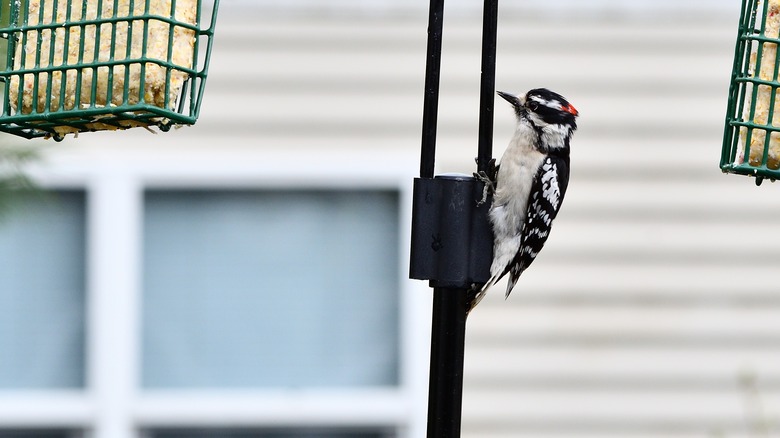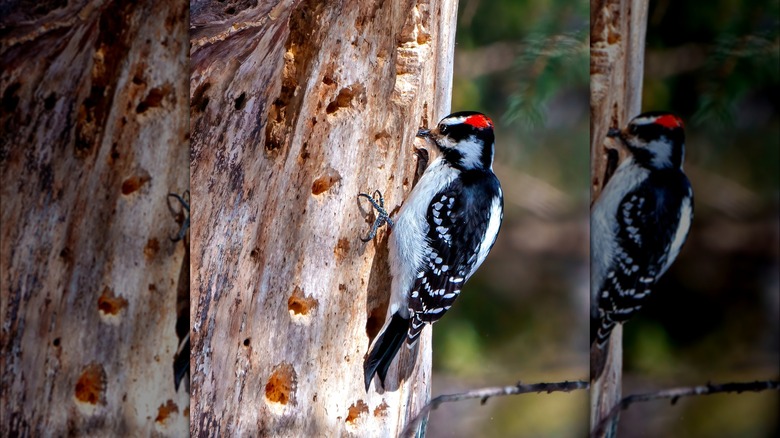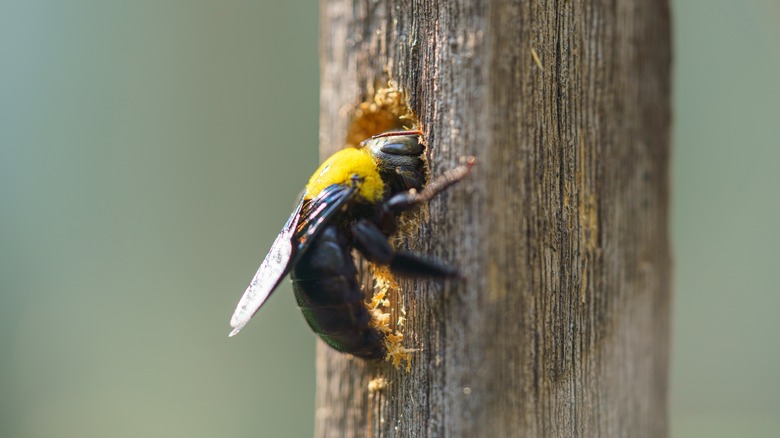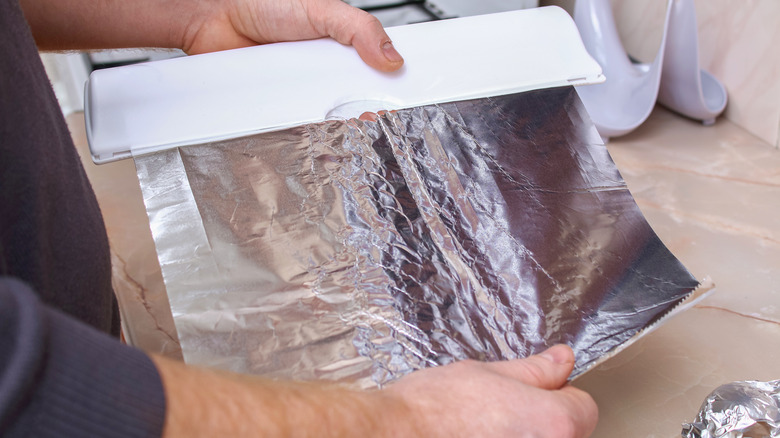4 Ways You Can Deter Woodpeckers From Your Home And Garden (And 1 To Avoid)
RA-TA-TA-TA-TA! Nope, the alarm clock hasn't lost its bits, blaring at an ungodly hour. It's the woodpeckers announcing to the world they're disposed to procreation. Unlucky for you, these migrating peckers and flickers keep hammering (technically "drumming") at the wood all spring until they find a mate and a nesting home. Seldom the wild staccato may restart around fall if their hairy woodpecker cousins reside in your area. Other times, their eager frenzies are provoked after catching the sound of their favorite meal, insects, crawling inside the tree tissues or your home's wooden siding. Plus, they go wild while hiding nuts. Irrespective of their motivations, one fact rings true: the avian musicians need to move elsewhere. Unfortunately, this doesn't come easy, as they're usually happy to keep boring holes in your home and garden. They're also unlikely to leave the area, given their aggressively territorial disposition.
There's another kicker to the deterrent equation. Being native to the United States has bestowed several species of woodpeckers with legal protection under the Migratory Bird Treaty Act. This means, neither you nor a professional exterminator can trap, remove, or put down these birds, no matter the damage, without an official permit from the U.S. Fish & Wildlife Service. Luckily, there are several methods to deter woodpeckers from homing in your yard. Be prepared to experiment, as the beak beaters' response varies across areas.
Give the drummers their own bongo
Have you wondered what propels woodpeckers into broadcasting their mating calls from your home's downspouts, TV antenna, chimneys, shingles, or rooftop ventilators? It's because the loudest one scores a partner. So, the avian drummers, after lots of experimentation (and nuisance!), eventually end at places offering the highest resonance. Naturally, dimming out the sound is one way to encourage the Vivaldi-wannabes to play their "The Four Seasons" somewhere else. This can be done by stripping off slack wooden pieces and substituting in padding. Follow it up by eliminating any openings or ledges that may serve as alights for drumming.
But if you don't want to miss out on the perks of birdwatching, earmark an alternate site in your garden for the peckers' orchestra and pop a "woodpecker bongo." Birthchild of Minnesota-based Richard (Dick) Hjort, a woodpecker bongo involves combining two lumber blocks (measuring 1 inch x 4 inch x 8 feet) and securing the united piece to a post or a tree in the desired location. Multiple bongos in varying lengths can be placed to attract spring-mating hairy and downy woodpeckers. You can alternatively mount a metal gutter cylinder to the tree as a crude drum.
Deter hungry woodpeckers through habitat modification
Occasionally, the reason woodpeckers drill tiny holes in neat rows around your home's cladding has more to do with food rather than signaling. Indeed, such fall behavior is often a cue to call in a professional to check for a possible pest infestation of carpenter or leaf-cutting bees. A 2009 Cornell University research found that grooved sidings — earthy or dark-toned stained ones, in particular — paired with high tree density (not grass) in the yard attract a load of foraging woodpeckers. However, the problem is most likely to be concentrated in the initial years post-construction. This is most common in cedar, redwood, and pine sidings, as wood-boring insects usually steer clear of hardened wood.
To prevent woodpeckers from ruining your home's siding, banish the insects' presence, including any overwintering larvae. Suffocating insects through insecticides or wood treatments might help, although the application may be difficult. Alternatively, you can fill in the dime-sized cavities with linseed oil. Later, paint over the holes or fill them with similarly toned putty to keep other woodpeckers from flocking in at the damaged site. Consider replacing wooden shingles with metal or tin to remove cover for insects. While some experts propose installing a suet feeder away from the house to sidetrack the starving peck-a-holics, this strategy may backfire by attracting a bigger swarm.
Install barriers to keep the woodpeckers away
Another method to deter woodpeckers from your home is to install physical barriers. For small-scale property damage, pivot to fastening ¼ inch thick hardware cloth or a wire mesh to the siding, eaves, vents, or chimneys. Otherwise, hook a ¾-inch thick bird netting — the kind used to prevent birds from munching on your garden fruit — from the eaves down the length of the walls suffering pecker's onslaught. In case of recurrent damage, switch to aluminum flashing and paint it over to blend it in with the walls. Similar strategies may be employed to protect ornamental trees from yellow-bellied sapsuckers who love boring rows of square holes to sucker up sweet sap and insects — a nylon draping or burlap will usually do the trick, but remove it in summer. Maintain a distance of at least 3 inches to prevent the incorrigible birds from pounding on the wood through the gaps. Also, ensure the netting is pulled taut so that it doesn't come loose during strong winds. Using wood lath or metal rods as netting support may provide better tension.
Harass the possessive birds back
If you catch the obstinate peckers early in action (before they become regulars), hose them with water to put them off track. Be prepared to run around the perimeter to keep up with the more passionate birds. Alternatively, use an aluminum foil hack to keep woodpeckers off your beloved trees. Simply cut the foil into strips measuring 18 inches long and 1½ inches wide, and hang them on the troubled sites. You can also substitute them for holographic Mylar tapes, as a 2007 Harding et al. study found that the rainbow reflectors work consistently across situations. Supplement them with aluminum pie tins, pinwheels (with reflective vanes), windsocks, or CDs to make the most of the reflected sunlight and wind action to confuse the birds. Move the deterrents regularly and keep at it for at least three weeks. Helium-filled, owl-eyed balloons may show some success but wall-mounted owl decoys, rubber snakes, or plastic hawks work rarely.
For better deterrence, combine these visual tactics with noise deterrents, including clapping, banging pots, or yelling to take out your frustrations. Noise guns work, too but avoid using distress calls or hawk sounds, as they aren't known to be effective. Caution: Using these measures is prohibited if the woodpecker variety visiting your yard is declared endangered in your state. For instance, Gilded Flicker and Gila Woodpecker are leveled extra protection in California. Also, these methods may scare away all kinds of birds from your yard, so tread accordingly.
Avoid using tactile gels on woodpeckers
Since woodpeckers aren't particularly gifted in the smell and taste department (sharply contrasting their cavity-building prowess), topical repellents are generally hopeless in discouraging their tapping. Polybutene-based tactile repellents, such as Tanglefoot, are an exception and are known to be effective in discouraging bird depredation when applied on gutters, chimneys, and desired trees. Unfortunately, they can have some alarming consequences for the birds. The sticky paste might mat their feathers, causing woodpeckers immense unease during their flight. Additionally, it may impede their ability to keep warm during cool weather. At times, the gluey repellent may also trap some juvenile birds or other small mammals, which can be downright cruel and prove fatal in certain cases.
On the flip side, applying tactile repellents to the sidings is not only difficult but also messy. They leave unsightly trails under the sun's scorching glare, leaving the area stained. They're extremely harmful when applied directly to bark tissues and twigs. Moreover, they collect dirt bunnies and dust, which lowers their effectiveness further.






